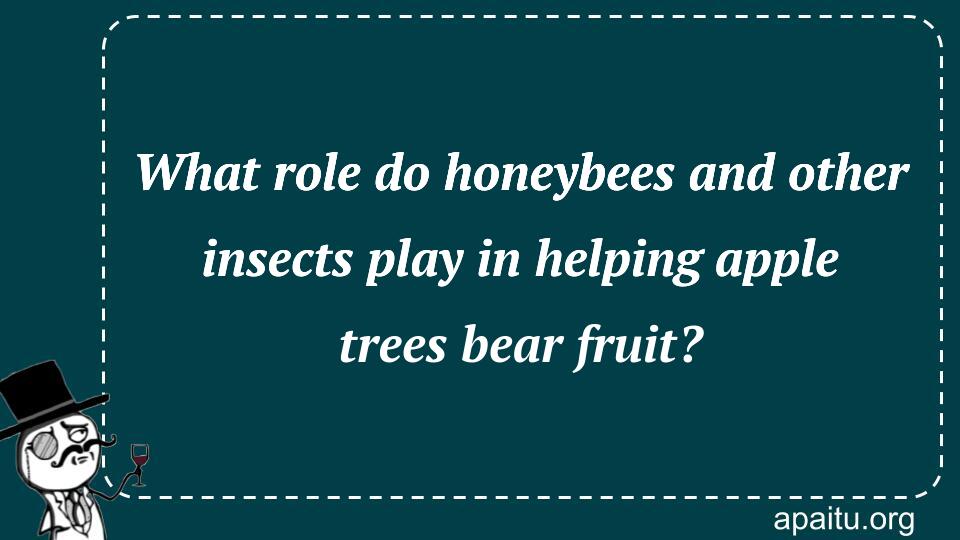Question
Here is the question : WHAT ROLE DO HONEYBEES AND OTHER INSECTS PLAY IN HELPING APPLE TREES BEAR FRUIT?
Option
Here is the option for the question :
The Answer:
And, the answer for the the question is :
Explanation:

Pollination: The Vital Role of Honeybees and Other Insects in Apple Tree Fruit Production
When you bite into a crisp, juicy apple, you may not realize the crucial role that honeybees and other insects play in bringing that fruit to your plate. Pollination, the process of transferring pollen from the male part of a flower to the female part, is essential for apple tree fruit production. This fascinating natural partnership between plants and pollinators ensures the formation of seeds and the development of healthy, flavorful apples.
Apple trees, like many other flowering plants, have both male and female reproductive structures within their flowers. The male parts produce pollen, while the female parts contain the ovules, which, when fertilized, develop into seeds. For successful pollination to occur, pollen must be transferred from the stamen (the male part) to the pistil (the female part) of the flower.
This is where honeybees and other insects enter the picture. As they forage for nectar and pollen, these busy pollinators inadvertently carry pollen from one flower to another. When they visit an apple blossom, tiny grains of pollen stick to their bodies, including their fuzzy bodies and the bristles on their legs. As they move from flower to flower, some of this pollen is transferred to the pistils, allowing fertilization to take place.
The mutual relationship between apple trees and pollinators is highly beneficial. Apple trees produce flowers that are rich in nectar and pollen, attracting bees, butterflies, flies, and other insects. In return for the food source, these insects inadvertently facilitate cross-pollination, which is essential for apple trees since they are not self-pollinating. Cross-pollination occurs when pollen from one apple variety is transferred to the stigma of a flower on a different apple variety, leading to the formation of genetically diverse and robust fruit.
Honeybees, in particular, are highly effective apple tree pollinators due to their behavior and unique characteristics. They have a remarkable ability to learn and remember the locations of apple blossoms, allowing them to efficiently visit multiple flowers in a single foraging trip. Honeybees also possess specialized structures on their legs and bodies that enable them to collect and transport large quantities of pollen.
The timing of pollination is crucial in apple tree fruit production. Apple blossoms have a relatively short window of opportunity for pollination, usually lasting only a few days. During this period, honeybees and other pollinators are essential in transferring pollen from flower to flower. If pollination does not occur within this timeframe, the flowers may not develop into fruit, leading to reduced yields.
It is worth noting that not all apple varieties require cross-pollination. Some apple trees are self-sterile, meaning they cannot pollinate themselves or produce viable seeds. These trees rely entirely on cross-pollination with another apple variety for fruit production. On the other hand, there are self-fertile apple varieties that can produce fruit with their own pollen, although cross-pollination can still lead to better fruit set and quality.
The significance of pollination in apple tree fruit production extends beyond the individual tree or orchard. It has broader implications for biodiversity and ecosystem health. By attracting and supporting populations of pollinators, apple orchards contribute to the conservation of these vital insects and the diversity of plant species in the surrounding environment.
However, the role of honeybees and other pollinators in apple tree fruit production is not without challenges. Factors such as habitat loss, pesticide use, climate change, and diseases like colony collapse disorder can negatively impact pollinator populations and their ability to effectively pollinate apple trees. This highlights the importance of promoting pollinator-friendly practices in orchards, such as providing suitable habitats, reducing pesticide use, and diversifying floral resources.
pollination, facilitated by honeybees and other insects, is a critical process in apple tree fruit production. These industrious pollinators play a vital role in transferring pollen between flowers, ensuring fertilization and the development of healthy apples. The mutual relationship between apple trees and pollinators highlights the interconnectedness of plants and animals in the natural world. By understanding and appreciating the significance of pollination, we can foster sustainable practices that support both apple production and the well-being of pollinator populations.